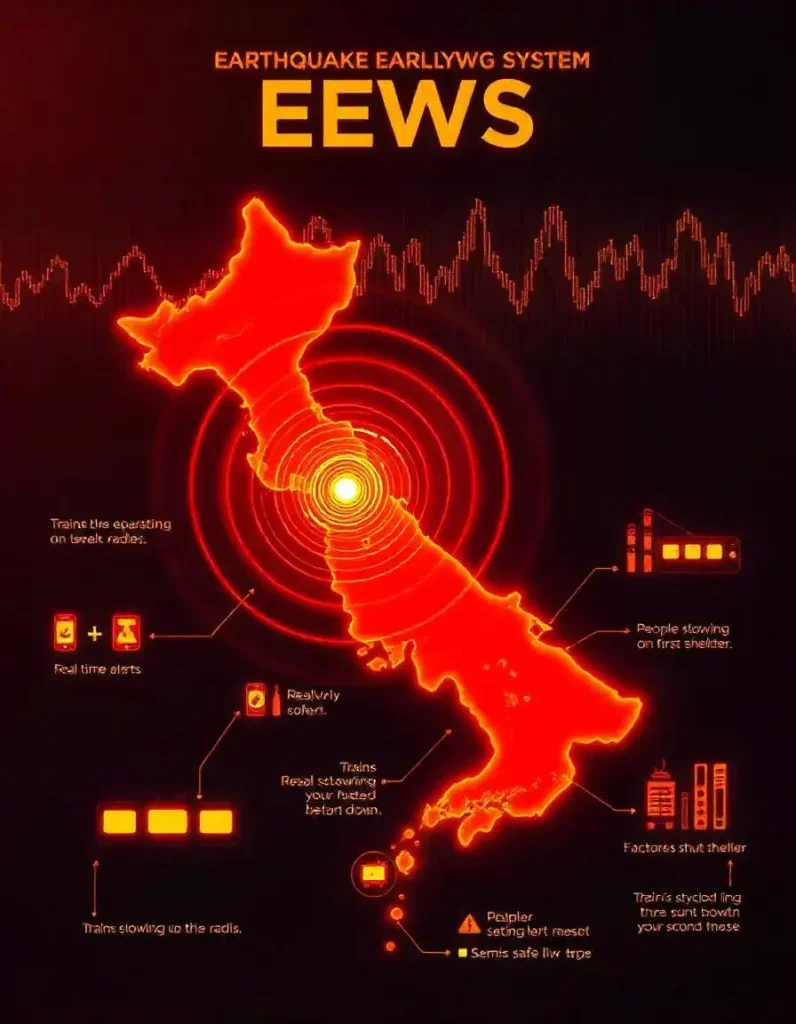The Power of Earthquake Notifications That Save Lives
Imagine this: A girl is live-streaming from Japan, laughing, and engaging with her audience. Suddenly, her phone buzzes. She glances at it, shows the screen to her viewers, and runs out of sight. Moments later, her stream shakes violently—an earthquake has struck.
But here’s the miracle: That buzz wasn’t just any message. It was an earthquake notification powered by Japan’s advanced Earthquake Early Warning System (EEWS). This ingenious technology warns millions of people seconds before the ground shakes, saving lives and preventing chaos.
Intrigued? Where did that technology come from, how does it work, and how is it revolutionizing the response to disasters in Japan?
Understanding Earthquake Notification: What Is the EEWS?
How the EEWS Works
Japan’s Earthquake Early Warning System (EEWS) is a cutting-edge network designed to detect earthquakes in real time. Here’s how it operates:
- Seismic Wave Detection:
- Earthquakes release two types of seismic waves:
- P-waves (Primary waves): These are fast but less destructive.
- S-waves (Secondary waves): These follow, causing significant damage.
- Sensors detect P-waves and relay this data to processing centers within seconds.
- Earthquakes release two types of seismic waves:
- Data Analysis and Alert Generation:
- Algorithms analyze wave data, calculating the epicenter, magnitude, and intensity.
- Alerts are instantly dispatched to mobile phones, televisions, radios, and public transport systems.
- Actionable Seconds:
- People receive notifications a few seconds to a minute before S-waves arrive. This window, though small, can mean the difference between life and death.
Why Seconds Matter in Earthquake Preparedness
While a few seconds may seem negligible, they are crucial. Here’s why:
- Evacuation: Residents can move to safer areas.
- Transportation Safety: High-speed trains are slowed to prevent derailments.
- Infrastructure Protection: Factories and power grids can shut down safely.
Source: Japan Meteorological Agency (https://www.jma.go.jp)
Why Japan Leads in Earthquake Notification Systems
The Need for Cutting-Edge Technology
Japan experiences 20% of the world’s earthquakes with magnitudes of 6.0 or higher. This vulnerability has made robust earthquake mitigation strategies a necessity.
- Historical Tragedies:
- The 1995 Kobe earthquake claimed over 6,000 lives.
- The 2011 Great East Japan Earthquake resulted in 15,899 fatalities and a devastating tsunami.
Integration with Daily Life
Japan’s earthquake notifications reach almost everyone:
- Mobile alerts are mandatory, covering 98% of the population.
- Public transport systems and industries are seamlessly linked to EEWS for automatic responses.
Investment in Safety
Japan has over 1,000 seismic stations, one of the world’s densest networks. This infrastructure allows the EEWS to provide alerts faster and more accurately than any other system globally.
Source: Earthquake Research Institute, University of Tokyo (https://www.eri.u-tokyo.ac.jp)
How Earthquake Notifications Are Saving Lives Today
Real-Life Impact Stories
- Education Sector:
In schools, earthquake drills synced with EEWS alerts teach children to “Drop, Cover, and Hold On,” drastically reducing injuries. - Transportation:
During the 2016 Kumamoto earthquake, alerts slowed down Shinkansen bullet trains, preventing derailments and protecting hundreds of passengers. - Public Awareness:
Apps like Yurekuru Call enhance awareness, providing real-time seismic data and tips.
Statistics That Prove Effectiveness
- The Japan Meteorological Agency reported a 98% accuracy rate in detecting earthquakes and issuing alerts.
- Studies show that EEWS notifications reduce fatalities by 20-30%, especially in urban areas.
The Future of Earthquake Notifications: AI and Beyond
AI-Powered Algorithms
Japan is integrating artificial intelligence to improve earthquake prediction accuracy. By analyzing past earthquake data, AI can forecast aftershocks and secondary disasters.
Global Adoption
Countries like the U.S., Mexico, and Taiwan are learning from Japan to develop their own EEWS networks.
Expanding Coverage
Efforts are underway to enhance alert systems for rural and remote areas, ensuring no one is left behind.
Wearable Technology
Innovative companies are designing wearables that sync with EEWS, providing personalized alerts through watches or fitness bands.
FAQs About Earthquake Notifications
Why are earthquake notifications important?
Earthquake notifications save lives by giving people a few seconds to prepare before strong seismic waves hit.
What is the accuracy of Japan’s EEWS?
Japan’s EEWS boasts a 98% accuracy in detecting earthquakes and issuing timely alerts.
Can earthquake notifications predict tsunamis?
While EEWS can detect earthquakes that may trigger tsunamis, separate systems monitor oceanic conditions for tsunami predictions.
Do other countries use similar systems?
Yes, countries like Mexico (SASMEX) and the U.S. (ShakeAlert) have developed earthquake early warning systems inspired by Japan.
How can I receive earthquake notifications?
In Japan, all mobile phones automatically receive alerts. You can also download apps like Yurekuru Call for detailed seismic data.
What should I do after receiving an earthquake notification?
Stay calm, move to a safe location, and follow emergency protocols. If indoors, shelter under sturdy furniture; if outdoors, avoid buildings and power lines.
Conclusion: Life-Saving Seconds with Earthquake Notifications
Japan’s earthquake early warning system proves how the country is customizable and ready to rise up and prevent disaster. It is not just about saving lives and offering hope and control within moments where people feel like there is none.
When all nations seek to replicate this model, Japan continues to embody strength, meaning that even in the context of global systemic shock waves, technology, and people have the potential to set the path for other nations to follow.



